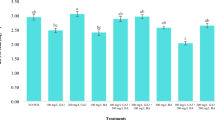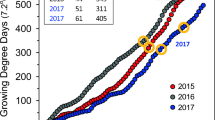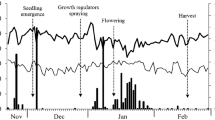Summary
Two growth retardants, B-nine (N-dimethylamino succinamic acid) and Phosfon (2,4-dichlorobenzyl-tributyl phosphonium chloride) were applied to tomato plants, either singly or in combination with gibberellic acid (GA), in order to determine various morphogenetic responses. GA (5 ml of 10− M 4 per plant) and B-nine (5 ml of 1.56×10−2 M per plant) were applied as foliar spray whereas Phosfon (1.5×10−3 M in 10 ml of water per plant) was applied as soil amendment. Growth retardation by Phosfon persisted through the time of harvest and was somewhat neutralized by GA. Fruit set and extent of seediness of fruits were the maximum in Phosfon-treated plants compared to others. Plants receiving B-nine, however, recovered from the initial growth retardation and indicated no residual action at harvest. GA in combination with B-nine produced significantly greater vegetative growth and dry weight accumulation than did GA alone. This indicated that applied and endogenous GA responded differently to different growth retardants. None of the treatments had any noticeable effect on the time of flowering.
Similar content being viewed by others
References
Baldev, B. and Lang, Anton, Control of flower formation by growth retardants and gibberellin inSamolus parviflorus, a long-day plant. Am. J. Botany52 408–417 (1965).
Brewbaker, James L. and Kwack, Beyoung H., The essential nature of calcium ion in pollen germination and pollen tube growth. Am. J. Botany50 859–865 (1963).
Bristow, J. Michael, The effect of gibberellic acid and cyclocel on the growth of cultured leaf tissue. Can. J. Botany44 513–518 (1966).
Cathey, Henry M., Physiology of growth retarding chemicals. Ann. Rev. Plant Physiol.15 271–302 (1964).
Cathey, H. M. and Stuart, N. W., Comparative plant growth-retarding activity of Amo-1618, Phosfon and CCC. Botan. Gaz.123 51–57 (1961).
Cleland, Robert, Evidence on the site of action of growth retardants. Plant and Cell Physiol.6 7–15 (1965).
Downs, R. J. and Cathey, H. M., Effects of light, gibberellin and a quaternary ammonium compound on the growth of dark-grown red kidney beans. Botan. Gaz.121 233–237 (1960).
Gustafson, F. G., Influence of GA on setting and development of fruits in tomato. Plant Physiol.35 521–523 (1960).
Kuraishi, Susumu and Muir, Robert M., Mode of action of growth retarding chemicals. Plant Physiol.38 19–24 (1963).
Lockhart, James A., Kinetic studies of certain anti-gibberellins. Plant Physiol.37 750–764 (1962).
Majumder, S. K., Kerns, K. R., Brewbaker, J. L. and Johannessen, G. A., Assessing self-incompatibility in pineapple by a pollen fluorescence technique. Proc. Am. Soc. Hort. Science84 217–223 (1964).
Ninnemann, H., Zeevaart, J. A. D., Kende, H. and Lang, A., The plant growth retardant CCC as inhibitor of gibberellin biosynthesis inFusarium moniliforme. Planta61 229–235 (1964).
Riddell, J. A., Hageman, H. A., J'Antohny, C.M. and Hubbard, W. L., Retardation of plant growth by a new group of chemicals. Science136 1044 (1962).
Sachs, R. M., Lang, A., Bretz, C. F. and Roach, Joan, Shoot histogenesis: Subapical meristematic activity in a caulescent plant and the action of gibberellic acid and Amo-1618. Am. J. Botany47 260–266 (1960).
Stuart, N. W., Initiation of flower buds in Rhododendron after application of growth retardants. Science134 52–54 (1961).
Tolbert, N. E., (2-chloroethyl) trimethyl ammonium chloride and related compounds as plant growth substances. II. Effect on growth of wheat. Plant Physiol.35 380–385 (1960).
Wittwer, S. H. and Tolbert, N. E., (2-chloroethyl) trimethyl ammonium chloride and related compounds as plant growth substances. III. Effect on growth and flowering of the tomato. Am. J. Botany47 560–565 (1960a).
Wittwer, S. H. and Tolbert, N. E., (2-chloroethyl) trimethyl ammonium chloride and related compounds as plant growth substances. V. Growth, flowering and fruiting responses as related to those induced by auxin and gibberellin. Plant Physiol.35 871–877 (1960b).
Zeevaart, Jan, A. D., Reduction of the gibberellin content ofPharbitis seeds by CCC and after-effects in the progeny. Plant Physiol.41 456–462 (1966).
Author information
Authors and Affiliations
Rights and permissions
About this article
Cite this article
Majumder, S.K. Morphogenetic responses of tomato plants to combined and individual applications of gibberellic acid, Phosfon and B-nine. Plant Soil 28, 291–297 (1968). https://doi.org/10.1007/BF01880246
Received:
Issue Date:
DOI: https://doi.org/10.1007/BF01880246




